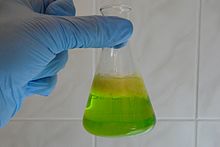Precipitation (chemistry)
![]()
This article explains chemical reactions. For the felling of a tree, see felling technique.
Precipitation or precipitation (from Latin praecipitatio 'the falling down') in chemistry refers to the precipitation of a solute from a solution. This occurs when its solubility is exceeded due to changes in its environmental conditions, e.g. addition of suitable substances (precipitants), changes in temperature and pressure, evaporation of the solvent or changes in the polarity of the solvent. Precipitation takes place as a precipitate in the form of amorphous flakes or crystalline material. Basically, a phase transition of the previously dissolved substance takes place.
An added precipitating agent can become part of the precipitate or convert the dissolved substance into a less soluble one, or only change the solvent properties of the solvent. The precipitates of the precipitated solids are initially mostly microcrystalline or amorphous. With time, recrystallization may result in the formation of a more stable crystal modification. Often these particles increase in size with aging due to additional agglomeration. This makes them easier to filter or form a sediment. As the precipitates age, their solubility often decreases further.
The formation of the precipitate or precipitate by precipitation can be triggered in several ways, by precipitation reactions, change in pH or exceeding the solubility product.
In biochemistry, precipitation is specifically the precipitation of proteins or nucleic acids. The effect of certain salts on the solubility of corresponding organic compounds is characterized by means of the Hofmeister series. Special precipitation methods in biochemistry include ammonium sulfate precipitation, PEG precipitation, TCA precipitation (denaturing), ethanol precipitation (denaturing) and heat precipitation (denaturing).
In wastewater treatment, in addition to precipitation with precipitants, flocculation using flocculants or flocculation aids is often used to remove colloidally dissolved substances.

Precipitation of uranyl carbonate

Limescale deposits on a leaking shut-off valve
Coprecipitation
Coprecipitation is a special form of precipitation in which the reactants are first brought into solution to ensure homogeneous distribution. Subsequently, the precipitation reaction takes place by mixing the two solutions or by adding a further solution; hydroxides or carbonates, among others, can be formed in the process. The now homogeneous solid mixture can then be filtered and further processed. This further processing can be, for example, firing in a furnace (e.g. in the case of nickel aluminate synthesis).
See also
- Precipitation analysis, hydration, solvation, precipitation (immunology)
- Sinter, impregnation (geology), mineralization from inorganic solutions
- Scavenger precipitation
- Material accumulation, sedimentation
- periodic precipitation
Search within the encyclopedia